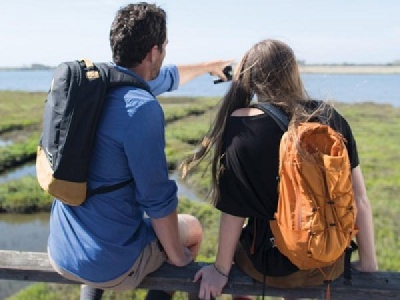
Posted on April 5, 2018
By Laura Saari, Orange Coast
Issued colorful gloves and told to yank out the invasive species, I joined 100 volunteers to comb the Bolsa Chica mesa in a cleanup that will be repeated twice this month. The Bolsa Chica Conservancy hosts many educational activities in what it likes to call its “Earth Month.”
“Don’t pull out the ones with the red stalk,” a high school student tells me.
The slender Inger Nelson, 52, an athlete and IT manager, is bent over beside me in the hot sun, her gloved hand stuffed with weeds. They’re South African ice plants, once a highway landscaping favorite that’s now taking over Orange County with the alacrity of the friars’ mustard seed.
“I ride my bike up and down past this all the time, and I come here to walk,” she says. “I thought it was time to get out here and do some volunteering.”
Thanks to required high school service hours, the Bolsa Chica Conservancy is awash in volunteers—up a few hundred percent in the past decade, says executive director Grace Adams.
But money is not so plentiful. Bolsa Chica means “Little Purse,” and this best describes its situation today, when there is no certainty whether the state’s June budget will fund a vital dredging operation the wetlands needs to survive.
Adams walks me out to a mesa, and we gaze across the placid, unmoving waters of the tidal basin.
“Without the life-giving tidal flow, the full tidal basin will silt over, and marine animals will die,” she says. “No fish can come in and provide nutrition for the birds. It will limit the areas where birds can find food, and we’re smack in the middle of the Pacific Flyway.”
An estimated 200 to 400 bird species check into the Bolsa Chica “hotel” annually, many on their way to somewhere else. Permanent residents, including the endangered Ridgeway Rail, have started breeding here, now that the area has been restored.
The battle for Bolsa Chica raged for nearly half a century, the earth lovers fighting the earth movers.
Over time, the state acquired some 1,550 acres, and development scaled back from a proposed 5,700 homes in the 1970s to about 300 homes.
Mitigation money to the tune of $100 million from the ports of Long Beach and Los Angeles helped create the preserve. But a flaw has resulted in a faster than anticipated sand buildup at the inlet, putting the preserve at the mercy of the state budgeting process. The California State Lands Commission owns the land, and it must petition annually for funds.
A potential hero from the business world, who could provide the wetlands the money it needs to remove salt from the water, also stands to profit from the work. The prospective donor is the Poseidon Water Huntington Beach Desalination Plant.
“We at the Conservancy would like to see the funding whether it’s from Poseidon or someone else,” says Adams, who believes Poseidon will offer $50 million to provide ongoing funds for dredging to prevent the full tidal basin from silting over.
But some consider it blood money.
“Poseidon is trying to buy off anyone they can to get their project approved,” says Debbie Cook, a former mayor of Huntington Beach. She belongs to a group that opposes Poseidon, and she served on the legal team suing the Coastal Commission in the 1990s on behalf of the Bolsa Chica Land Trust. “They’ve been doing this for over a decade, giving money to organizations to get their support. … But it’s a no-bid contract. We would have to take their water. This should be a public project. We don’t need a private company to come in here from the East Coast and tell us how much water we need.”
As I stand beside Adams and look down over the long, cool waters of the marsh, it’s as if the water itself enters my bloodstream. Was it worth saving? Heck, yeah, it was worth saving. We owe an eternal debt to all those who came before, wresting Bolsa Chica from the oil drillers, the duck hunters, and the mansion builders.
In February, the state reached into our “little purses” as the California Department of Fish and Wildlife began to charge admission to Bolsa Chica ($4.32 for day or $25.10 for the year—the spare change helping pay for the smartphone reading equipment that collects your fees). Maybe they’ve already spent that money, but it seems reasonable the state could give some of it back to help pay for the dredging.
It’s hard to imagine after all those hard-fought years that we could allow the sand to pile up, and the ocean, once again, to be shut out.
Source: Orange Coast





